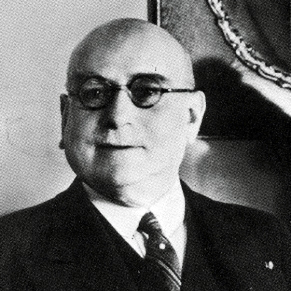Templier Raymond

Templier (founded 1849)
Templier, Charles (1821 – 1884)
Templier, Paul (1860 – 1948)
Templier, Raymond (1891 – 1968)
Charles und Raymond Templier, hailing from a Paris family of goldsmiths, make jewellery history with their masterful pieces of jewellery – some parts fantastically enamelled, other parts innovatively minimalistic – created in the styles of Historism and especially Art Déco.
Charles Templier begins working in 1848 with a business located on the Rude de Rivoli. Upon his death in 1885, his son Paul takes over the business. Like his father, he is active in the goldsmith guild and beginning in 1907 succeeds Louis Aucoc as president of the association of metalsmiths and jewellers. Raymond is born in 1891. The house of Templier successfully participates in many important exhibitions at the beginning of the 20th century, including those in Glasgow, Turin and Casablanca. In 1909 Raymond attends the art school in the Louvre. By 1911 he is already exhibiting at the Salon des Artistes Décoratieurs of the Société Nationale des Beaux-Arts, as well as at the Salon d’Automne. Early on he abandons/turns away from the style of Art Nouveau and experiments with geometric forms. He gets a lot of attention for his severe clips and brooches, and his play with forms and colours. He works as a translator and driver during the First World War. Art Déco pieces of jewellery, which Raymond himself fashions using enamel and diamonds, offer a new aesthetic and create quite a stir in Paris in 1925. When Raymond uses gemstones, he looks for the perfect roundness and simplest form. He adores lapis lazuli, corals, malachite and chalcedony, and uses them to create polychrome jewellery sculptures. In 1928 he exhibits his lacquered cigarette cases, rings and cufflinks next to works from Fouquet and Sandoz. His former school colleague, Marcel Percheron (1910-1991) joins the company as an illustrator in 1929. He produces the sketches for Raymonds eccentric jewellery concepts. For trapezoidal pendants, he combines green and grey enamel with diamonds that possess an astounding brilliance. The results are bracelets whose sections are made of alternating grey and red gold or from grey gold and platinum. Templier’s jewellery presents a new radical, pure abstraction. For the powerful and dynamic lines and forms, he seeks his inspiration from machines and technology. Like his father and grandfather, Raymond also dedicates himself to the goldsmith craft. He is the secretary for the association of Art Déco artists. In the 1930s he exhibits his jewellery in Germany, England and the USA. He experiments with eggshells and other new materials. In 1938 Paul Templier receives the Legion of Honour and celebrates his company’s 50th anniversary. He dies in 1948. Raymond withdraws from the family business in 1965. In 1966 the Musée des Arts Décoratifs in Paris honours him with the exhibition „Les années 20, Art Deco/Bauhaus/Esprit Nouveau“. Raymond Templier dies in 1968.
Templier, gegründet 1849
Templier, Charles 1821 – 1884
Templier, Paul 1860 – 1948
Templier Raymond 1891 – 1968
Aus der Pariser Goldschmiederfamilie schreiben Charles und Raymond Templier mit ihren meisterhaften, teils fantastisch emaillierten, teils innovativ minimalistischen Schmuckstücken im Stil des Historismus und besonders des Art Déco Schmuckgeschichte.
Charles Templier beginnt 1848 mit einer Juwelierfirma in der Rude de Rivoli. Als er 1885 stirbt übernimmt Sohn Paul das Unternehmen. Wie sein Vater engagiert er sich in der Goldschmiedeinnung und ist ab 1907 der Nachfolger von Louis Aucoc als Präsident des Verbandes der Kunstschmiede und Juweliere. 1891 kommt Raymond auf die Welt. Das Haus Templier nimmt zu Beginn des 20. Jahrhunderts erfolgreich an vielen wichtigen Ausstellungen teil, darunter die in Glasgow, Turin und Casablanca. 1909 besucht Raymond die Kunsthochschule im Louvre. Bereits 1911 und in den nachfolgenden Jahren stellt er bei der Société Nationale des Beaux-Arts im Salon des Artistes Décoratieurs sowie im Salon d’Automne aus. Schon früh wendet er sich vom Stil des Art Nouveau ab und experimentiert mit geometrischen Formen. Aufmerksamkeit erregen seine strengen Clips und Broschen, sein Spiel mit Formen und Farben. Während des Ersten Weltkrieges fungiert er als Übersetzer und Fahrer. Die von Raymond selbst entworfenen und ausgeführten Art-Déco-Schmuckstücke in Email und mit Diamanten, erregen wegen des neuen Looks in Paris 1925 großes Aufsehen. Wenn Raymond Steine verwendet sucht er die perfekte Rundung und schlichteste Form. Er liebt Lapizlazuli, Koralle, Malachit und Chalcedon und macht aus ihnen polychrome Schmuckskulturen. 1928 stellt er seine lackierten Zigarettenetuis, Ringe und Manschettenknöpfe neben Arbeiten von Fouquet und Sandoz aus. Als Zeichner kommt 1929 sein ehemaliger Studienkollege Marcel Percheron (1910 – 1991) ins Unternehmen. Er fertigt die Skizzen zu Raymonds ausgefallenen Schmuckideen. In trapezförmigen Anhängern kombiniert er grünes und graues Email mit Diamanten, die eine erstaunliche Brillianz haben. Es entstehen Armbänder, deren Glieder abwechselnd aus grauem und rotem Gold oder aus grauem Gold und Platin bestehen. Templiers Schmuck ist von einer radikal neuen, puren Abstraktion. Für die kraftvollen und dynamischen Linien und Formen lässt er sich von Maschinen und Technik inspirieren. Wie Vater und Großvater engagiert sich auch Raymond für das Goldschmiedehandwerk. Er ist der Sekretär der Vereinigung der Art-Déco-Künstler. In den 1930er Jahren stellt er seinen Schmuck in Deutschland, England und den USA aus. Er experimentiert mit Eierschalen und anderen neuen Materialien. 1938 erhält Paul Templier den Legion d’Honneur und feiert 50jähriges Firmenjubiläum. Er stirbt 1948. Raymond zieht sich 1965 aus dem Familienunternehmen zurück. 1966 ehrt ihn das Musée des Arts Décoratifs in Paris mit einer Ausstellung „Les années 20, Art Deco/Bauhaus/Esprit Nouveau“. 1968 stirbt Raymond Templier.